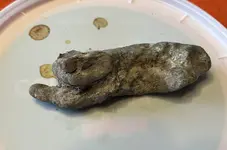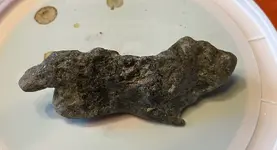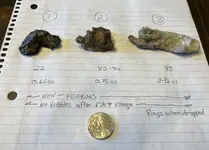This blob of metal is 2-1/2 oz. I tried testing it with various methods available to me. It does NOT mark a white sheet of paper. It does darken when bleach is dropped on it, but most things get darker when wet. Very hard to scratch with a knife, but it can be done. Seems WAY heavier than aluminum slag. It is non-ferrous. I don’t believe it is a rock; if it is, it is almighty heavy. It was found near the surface of a farm dump. I’m very intrigued with it. Tried an ice cube test. The ice melts freaky fast. Vinegar had basically done nothing earlier.
You are using an out of date browser. It may not display this or other websites correctly.
You should upgrade or use an alternative browser.
You should upgrade or use an alternative browser.
🔎 UNIDENTIFIED I give up…
- Thread starter Blackfoot58
- Start date
- #21
Thread Owner
No bubbles. I can’t buy the aluminum idea. I’ve seen a lot of aluminum slag and this has a much higher density IMO. I’m going to see if it can be tested economically. I’d guess it was 3x the density of aluminum slag I’ve seen. ThanksIt's kind of an ugly looking thing.
Do a density test.
Simple enough to achieve.
Shiny and hard could be a bunch of things.
Melted Zinc die-cast is a common thing also.
Hit a spot with the file or grinder. Then put vinegar on the spot.
Bubbles 🫧 fizzles then it's Zinc. Nothing then go to aluminum cast idea.
Upvote
0
Do a simple density test.No bubbles. I can’t buy the aluminum idea. I’ve seen a lot of aluminum slag and this has a much higher density IMO. I’m going to see if it can be tested economically. I’d guess it was 3x the density of aluminum slag I’ve seen. Thanks
Then look up what it could be.
I'm sure you can figure it out.
Last edited:
Upvote
1
I added a link to the previous post explaining it the Government way.🤣I’ll need to do a water displacement to achieve the number I need for cm3
I'm sure there's a video explaining this in a simpler way.
Upvote
2
- #25
Thread Owner
Here is a comparison across 3 slag chunks I’ve found. #1 is scaly, flakes apart easily, but is not soft. It hits a solid 22 ID on my Simplex in Park2 mode. #2 & #3 are very similar to each other. Both are hitting ID of 85-86 on Park 2 mode. The big difference: #3 has a bell-like ring when dropped on something solid, the others do not. #2 visually reminds me a lot of the slag we used to see on railroad beds in the 60s. I’ll do other testing. Just wanted to add these facts to the pool.
Attachments
Upvote
0
Duly noted on the latest findings.Here is a comparison across 3 slag chunks I’ve found. #1 is scaly, flakes apart easily, but is not soft. It hits a solid 22 ID on my Simplex in Park2 mode. #2 & #3 are very similar to each other. Both are hitting ID of 85-86 on Park 2 mode. The big difference: #3 has a bell-like ring when dropped on something solid, the others do not. #2 visually reminds me a lot of the slag we used to see on railroad beds in the 60s. I’ll do other testing. Just wanted to add these facts to the pool.
Aluminum rings like no tomorrow when dropped on something solid.
I'm going do this gently now.
Please don't take what a metal detector ID as gospel.
See there has been endless references from folks that have really thought they had a precious metal, and it turned out to be just a non-ferrous something else.
Then came the old but, but the screen/dial/needle went to gold-I don't believe anyone, as the story has been repeated many a time over the past 60 years.
The only way is to do an actual acid/density/XRF test on the piece.
The detector will tell you an approximation of what it believes the alloy is actually.
If a detector was so accurate folks would be spending $$$ on detectors instead of $25K on a XRF
Upvote
2
- #27
Thread Owner
Water displacement test done. Based on this this test, the slag has a density of 5.204 (original picture of 2.5 oz chunk). A friend said that would most closely resemble europium; which is a density of 5.24. Not close to aluminum (2.6) or nickel (8.9). He did question the purity of the sample. It could have, sand, rock, etc bastardizing the test. We neither suspect it is europium; radium has a density of 5.0. Next stop jeweler.
Upvote
1
:max_bytes(150000):strip_icc()/90191671-56a1322a3df78cf772684fbf.jpg)
How Does a Flame Test Work?
The flame test is an analytical chemistry method used to help identify numerous metals and metalloids.
See what colour flame it produces.
Upvote
0
- #29
Thread Owner
Will do. Thanks. Previously I heated the edge and saw no color change to the flame. I’ll try the filingsGet some filings and do a 🔥 test.:max_bytes(150000):strip_icc()/90191671-56a1322a3df78cf772684fbf.jpg)
How Does a Flame Test Work?
The flame test is an analytical chemistry method used to help identify numerous metals and metalloids.www.thoughtco.com
See what colour flame it produces.
Upvote
1
Finer the better, don't inhale the smoke either. (nasty)Will do. Thanks. Previously I heated the edge and saw no color change to the flame. I’ll try the filings
Upvote
0
dirstscratcher
Full Member
I'm guessing babbit from a bearing pour. Much old farm machinery had bearings that were poured in place on the farm. I think old Ford cars and trucks had as well. I remember dad pouring some when I was a kid.
Upvote
2
- Joined
- Aug 19, 2014
- Messages
- 38,802
- Reaction score
- 142,467
- Golden Thread
- 0
- Location
- Tarpon Springs
- Detector(s) used
- JW 8X-ML X2-VP 585
- Primary Interest:
- All Treasure Hunting
Possibly fire nugget of 316 or higher stainless steel.
Upvote
0
The outer shell of the bearing could be ferrous-the actual Babbitt lining consists of "Non-Ferrous" white metals generally.Wouldn’t that be ferrous?
Here's an explanation:
"Babbitt is a white metal alloy that was patented by Isaac Babbitt in 1839. Over time, the term Babbitt has been applied to other similar white metals comprised of tin, copper and antimony. Lead can sometimes be added in place of the tin."
Here is a ingot of bearing Babbitt I got nearly 30yrs ago.
Upvote
1
- #35
Thread Owner
Up-date. Took this to a jewelry store today. 2 jewelers looked at it and tested it. They could not solve the mystery, but I now know a few things it is not: they ruled out silver, gold, aluminum, brass, bronze and lead. They got caught up in the item and kept commenting about it; let’s try one more test, etc. Finally they said I could send it to their smelter. It would cost me $25 to have it ID’d. If it is not worth that much, then I be out.
After the acid test, one jeweler said his best guess based on reaction would be tin, but the weight is all wrong for tin. Possibly nickel and tin melted together. I’m not spending $25 on it. How do I close this without a solution? I want to do it right. Thanks to all who responded and encouraged me.
After the acid test, one jeweler said his best guess based on reaction would be tin, but the weight is all wrong for tin. Possibly nickel and tin melted together. I’m not spending $25 on it. How do I close this without a solution? I want to do it right. Thanks to all who responded and encouraged me.
Upvote
0
- #36
Thread Owner
I forgot this tidbit, one jeweler was surprised at the bell-like tone it made; extremely clear and tonal.Up-date. Took this to a jewelry store today. 2 jewelers looked at it and tested it. They could not solve the mystery, but I now know a few things it is not: they ruled out silver, gold, aluminum, brass, bronze and lead. They got caught up in the item and kept commenting about it; let’s try one more test, etc. Finally they said I could send it to their smelter. It would cost me $25 to have it ID’d. If it is not worth that much, then I be out.
After the acid test, one jeweler said his best guess based on reaction would be tin, but the weight is all wrong for tin. Possibly nickel and tin melted together. I’m not spending $25 on it. How do I close this without a solution? I want to do it right. Thanks to all who responded and encouraged me.
Upvote
0
- Joined
- Aug 19, 2014
- Messages
- 38,802
- Reaction score
- 142,467
- Golden Thread
- 0
- Location
- Tarpon Springs
- Detector(s) used
- JW 8X-ML X2-VP 585
- Primary Interest:
- All Treasure Hunting
...Possibly fire nugget of 316 or higher stainless steel.
Upvote
0
Tedyoh
Bronze Member
Only issue with this theory is that a camp fire falls about 1000 deg F. short of being able to melt stainless...stainless would need to be melted in a furnace....probably industrial size....I don't think a hobbyist furnace even gets hot enough (I have one).....being found a farm I would think it's some sort of aluminum/tin/zinc/ lead/pewter "common metal alloy" mixed at who knows what percentages.....
Upvote
2
- Joined
- Aug 19, 2014
- Messages
- 38,802
- Reaction score
- 142,467
- Golden Thread
- 0
- Location
- Tarpon Springs
- Detector(s) used
- JW 8X-ML X2-VP 585
- Primary Interest:
- All Treasure Hunting
Agreed... and i think temp is higher than 1000... but i have seen melted glass before as well... it is rare and i am null on any thought of anything else that fits in OP's realm of possibilities of materials that it could be that also is fitting into descriptions.Only issue with this theory is that a camp fire falls about 1000 deg F. short of being able to melt stainless...stainless would need to be melted in a furnace....probably industrial size....I don't think a hobbyist furnace even gets hot enough (I have one).....being found a farm I would think it's some sort of aluminum/tin/zinc/ lead/pewter "common metal alloy" mixed at who knows what percentages.....
It is rare that a fire can melt most items... but it can happen i guess if all the right things happen.
I have found pooled melted glass in fire pits.
Upvote
1
- #40
Thread Owner
I did find melted glass in the same area.Agreed... and i think temp is higher than 1000... but i have seen melted glass before as well... it is rare and i am null on any thought of anything else that fits in OP's realm of possibilities of materials that it could be that also is fitting into descriptions.
It is rare that a fire can melt most items... but it can happen i guess if all the right things happen.
I have found pooled melted glass in fire pits.
Upvote
1
Similar threads
- Suggestion
- Replies
- 4
- Views
- 732
- Suggestion
- Replies
- 10
- Views
- 1K
Users who are viewing this thread
Total: 1 (members: 0, guests: 1)







